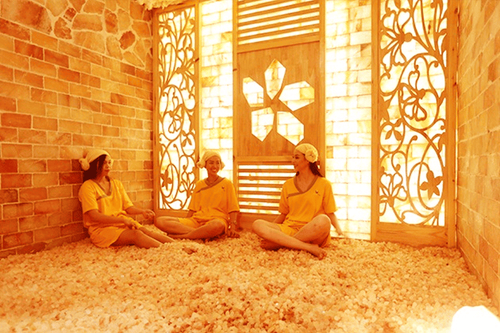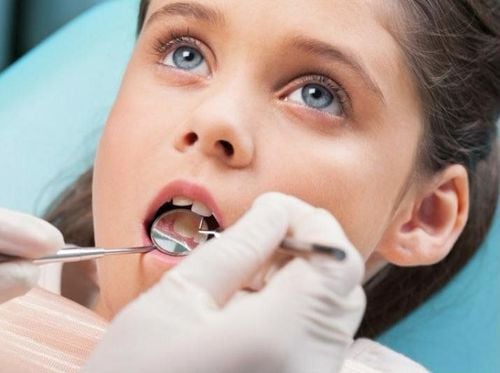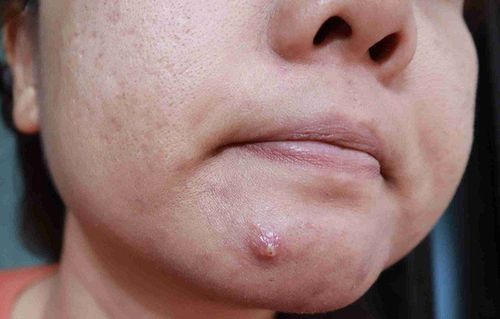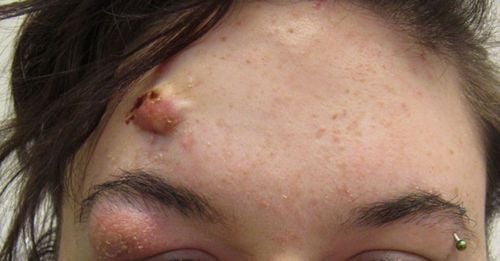This is an automatically translated article.
Skin needs time to relax and detox just like you do after a tiring day at work. Deep cleansing of the face is an important step in the skin care and improvement cycle. While a deep cleansing routine can involve many different steps, it is an effective skin care routine that is suitable for all skin types.
1. Sauna Method
Before steaming your face, wash your face well.
Before you wash your face, you should wash your hands first. Wet your hands and make a lather. Then scrub for 20 seconds, making sure to rinse well between your fingers, under your fingernails and the back of your hands. To keep track of hand washing time, hum "Happy birthday" from beginning to end twice. Rinse thoroughly and dry with a clean towel or disposable paper towel. Use mild soaps, limit products containing oils, chemicals and warm water. If you have makeup on, remove it thoroughly before starting the steaming process. Makeup can clog pores, leading to breakouts. You should deep clean your face before applying makeup. Heat a pot of water. Pour water into a pot and bring to a boil. Heat the water until it starts to produce steam. You should not boil the water until it boils, as this can burn your face.
Add essential oils. It is recommended to add essential oils to the water to help clean and nourish your skin. If you are facing pimples or acne, bergamot oil has antiviral and antibacterial properties that can reduce breakouts. Geranium oil is also great because it increases skin elasticity and regulates oil production in the skin. Tea tree oil has been known to eliminate acne-causing bacteria. If you are prone to frequent breakouts, lemon oil can shrink your pores and reduce the likelihood of breakouts. If you're looking to improve the look of your skin, there are several options. Lavender oil can lighten the skin and reduce the appearance of scars and blemishes. Carrot seed oil also rejuvenates the skin by encouraging cell renewal. Myrrh has certain anti-aging properties that can keep skin youthful and flawless. Peppermint or green tea, although not essential oils, can still be added to the water to increase the moisturizing effect. After the water has evaporated and the essential oils have been added, wrap a towel around your head and face, leaning over to catch the hot steam so that the steam comes into contact with your face. However, don't bow too much because you don't want the hot water to touch your face directly because hot water will most likely burn your face. If it feels too hot, wait a few minutes and let the water cool down before starting the steaming process.
You can also try steaming your face with a home steamer. This is a safer method and can provide steam for a longer time. Wash and moisturize your face. After 10 minutes of steaming, you can wash your face. Take out the towel and pour out the steamed water bowl. Rinse the surface with cool water. Some dead skin cells, dirt and debris that emerge during the cleaning process will be washed away. Dry the surface with a clean towel. Use facial moisturizer after cleansing. Moisturizer will help keep your skin hydrated and maintain better elasticity.

Xông hơi giúp làm sạch sâu da mặt
2. Cleanse face with oil
Make a mixture of castor oil and extra virgin olive oil. Castor oil and olive oil work to deep clean the pores, moisturize the skin and prevent further acne.
Castor oil and olive oil should be mixed in a 1:4 ratio. This means 4 parts olive oil for every part castor oil. For example, if you use 1 teaspoon of castor oil, use 4 teaspoons of olive oil. If you use 2 teaspoons of castor oil, use 8 teaspoons of olive oil and so on. Mix the oils together in a bowl. Massage the oil mixture onto your face. Gently massage the oil into your face with gentle, circular motions. You should wash your hands first and make sure to apply the oil to your entire face. Place the hot towel on your face three times. For the treatment to be effective, you need to cover your face with hot water three separate times.
Dip the towel in hot water. Because the towel is directly on the face, the water should not be boiling or too hot as it can burn the skin when applying the towel to the face. If the water is too hot for you to wring the towel dry, it cannot be used on your face. Try putting a towel on your arm to check the temperature before applying it to your face. Place a towel on your face and leave it on until it cools. Repeat this process two more times. Wipe off the oil. Using a clean washcloth or disposable tissue, gently wipe away any remaining oil and water from your face. Your skin will then take on a healthy glow, and blemishes and scars will fade.
3. Exfoliate dead skin cells
Buy facial scrubs. Facial scrubs are available in most supermarkets, drug stores, and cosmetic stores. They usually contain small granules designed to remove dead skin cells.
Prices of exfoliating products are very diverse. Some are quite expensive, selling for $30, while others can cost less than $10. Referring to product reviews in beauty magazines or social networking sites can help you make an informed decision to choose the best exfoliator for you.
Exfoliating has been criticized by environmentalists. Many scrubs use plastic beads that are hard to break down and this leads to pollution in large lakes and other bodies of water. To limit the harmful impact on the environment, you should choose to make your own eco-friendly scrubs at home.
Make a scrub with sugar and honey. A simple brown sugar and honey scrub can help exfoliate the skin and is very simple to make. If you're frugal or don't count on using a lot of plastic in some scrubs, this might be a better option. Mix honey and brown sugar in equal proportions. Store in an airtight container at room temperature.
Rub in a circular motion. Using your chosen exfoliator, allow the mixture to penetrate your skin. Massage in circular motions. Rub for about two minutes. Be gentle. The beads will exfoliate your skin without too much pressure from rubbing.
Wash your face and apply moisturizer. After you've exfoliated for two minutes, use water to remove the honey and sugar from your skin. Wash until skin is clean and then pat dry with a clean towel. Wait a few minutes and then apply a light facial moisturizer that doesn't contain too much oil. Be careful not to over-exfoliate. Exfoliating too much can cause redness, irritation, and other skin problems.
4. Use a pore-cleansing mask
Use Milk and Gelatin
A popular cleansing mask that you can make yourself is a simple mixture of full-fat cow's milk or goat's milk and gelatin. This is a good option if you are looking to get rid of blackheads. Go to a nearby supermarket and buy milk and gelatin, which can often be found in canned powder form.
Mix milk and gelatin in two equal parts. Stir until gelatin dissolves in milk, then microwave for 5 seconds. Let cool for a few minutes, then microwave for another 5 seconds. Wait until the mixture cools down to room temperature. Put it on your nose and let it sit for 10 minutes. It will form a thick mask that you can peel off after 5 minutes. This process will help remove blackheads. Egg white and lemon juice mixture
An alternative treatment option to remove blackheads is a mixture of egg whites and lemon juice.
Use one egg white and one teaspoon of lemon juice. Whisk the mixture together and apply to the skin, targeting the areas you want to cleanse. Place a paper towel or face towel on top. Leave the mask on until it is dry enough to peel off. Gently peel off the entire layer of tissue paper. You'll have smoother, fresher-looking skin, fewer blackheads, and smaller pores. Avoid using this method if you have particularly dry or sensitive skin, as it can cause irritation. Use whole milk and honey
Both full fat milk and raw honey have antibacterial and antifungal properties that help deep clean the skin.
Mix milk and honey in equal proportions. Place the mixture in the microwave and heat until it becomes thick and sticky. Wait for it to cool to room temperature. Then, apply the mixture on your face. Leave on for 25 minutes and then gently peel off. Use fresh or dried parsley
Parsley is a great ingredient for any face wash.
Parsley helps fade dark spots on the skin and also helps clear clogged pores. You can add dried or fresh parsley to many homemade or store-bought face masks. You can also use fresh parsley on your own by soaking the head of parsley in warm water, wetting a washcloth with that water, and applying this water to your face for 10 or 15 minutes. Use a clay mask
Clay mask is one of the most popular masks used for deep cleansing of the skin. Clay has skin cleansing properties and helps remove blackheads.
The price of clay masks varies depending on whether you buy the mask at a store or supermarket. As with any other skin product, check out product reviews in beauty magazines and social media sites so you can make an informed decision. Most store-bought clay masks will come with instructions for use. Read these instructions carefully and follow them when using the mask. Always apply a small amount of product to your arms or legs before applying to your face to watch for an allergic reaction if any.
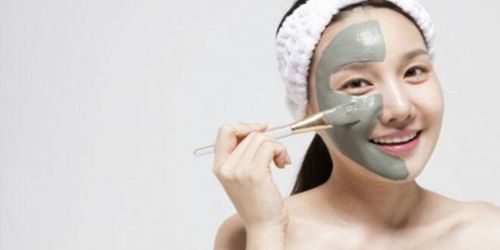
Mặt nạ đất sét là một trong những loại mặt nạ phổ biến nhất được sử dụng để làm sạch sâu cho da
Please dial HOTLINE for more information or register for an appointment HERE. Download MyVinmec app to make appointments faster and to manage your bookings easily.





